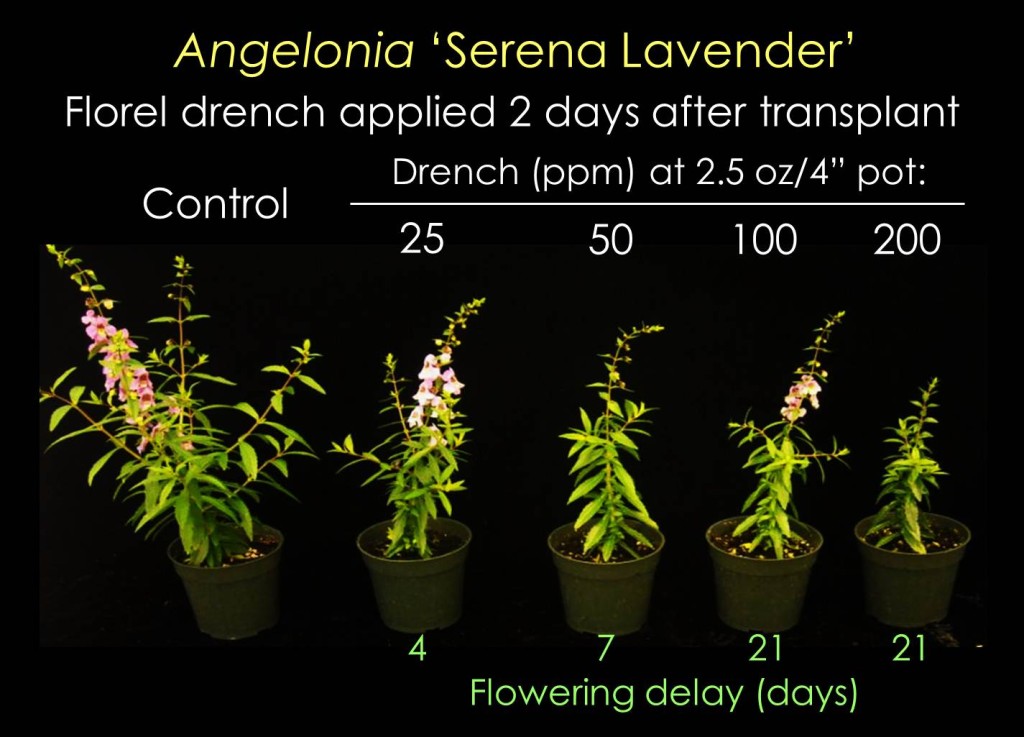
Ethephon Drenches on Bedding Plants
The plant growth regulator (PGR) Florel has been used for many years as a foliar spray on a wide variety of ornamental crops as well as some food crops. Until recently, Florel was only thought to be effective when applied as a foliar spray. At the OFA Short Course in 2008, presenters John Erwin, Royal Heins and Peter Konjoian discussed how Florel also had growth-regulating activity when applied as a substrate drench. They presented insights from grower trials and set the stage for potentially using Florel as a drench.
Since then, we performed controlled research studies investigating floriculture crop responses to Florel drenches. In the March 2013 issue of GPN, we discussed the properties and ethylene release characteristics of Florel in commercial substrates, as well as the desirable growth-regulating effects of drenches on daffodils and hyacinths. Here, we summarize Florel drench responses for seed and vegetatively propagated bedding plant crops. It is important to note that presently neither Florel nor the new PGR Collate, which both contain the same active ingredient ethephon, are labeled for drench applications.
Experiments were performed at Cornell University, Michigan State University (MSU) and Purdue University on 24 cultivars of bedding plants grown in peat-based substrates in 4- or 4_-inch pots. Applications were made two days (at Cornell) or 10 days (at MSU and Purdue) after transplant of plugs or liners during the spring and summer. Overhead drenches were made at rates between 25- and 200-ppm Florel at volumes of 2.5 ounces per 4-inch pot (Cornell), 2 ounces per 4-inch pot (MSU), or 2.5 ounces per 4_-inch pot (Purdue). Plants were grown at 65 to 70¡ F in all three locations following standard growing practices (e.g., watering and fertility) and a variety of data were collected.
Results on Bedding Plants
Compared with untreated (control) plants, a Florel drench reduced plant height at flowering of nearly all bedding plant crops studied, and the effect increased with increasing concentration (Table 1). Not surprisingly, the magnitude of the responses varied among the crops studied. A Florel drench had a moderate to strong effect on suppressing plant height of angelonia, celosia, geranium (seed), petunia, tomato, verbena and vinca. However, flowering was also delayed in these crops, and the delay generally increased as the drench concentration increased. The only crops in which a Florel drench had an inhibitive effect on plant height with little or no flowering delay were argryanthemum, dianthus, seed impatiens and snapdragon.
The effects of Florel are illustrated in Figures 1 through 5. In angelonia, a single 25-ppm drench inhibited plant height at flowering by 16 percent and a 50-ppm drench produced plants that were 35 percent shorter than untreated plants (Figure 1). Shoot and root growth were also substantially inhibited. Responses were similar in celosia, where a 25-ppm Florel drench reduced plant height by 36 percent and a 50-ppm drench reduced height by 53 percent (Figure 2). Therefore, for these and other crops with a moderate to strong response, relatively low rates (20 to 40 ppm) are suggested as a starting point for small-scale drench trials. For crops with a small to moderate response to a Florel drench, rates between 50 and 75 ppm are suggested. Generally, the highest rate tested (200 ppm) produced similar responses as a 100-ppm drench and therefore, a rate greater than 100 ppm is not recommended on bedding plants.
A Florel drench noticeably decreased shoot and root mass (as measured by weight) in nearly all of the crops measured. In calibrachoa, a single 50-ppm Florel drench reduced shoot mass by 40 percent and root mass by 31 percent (Figure 3). Similarly, a 50-ppm drench reduced nemesia shoot growth by 35 percent and root growth by 29 percent. Therefore, the Florel drenches decreased both height and the overall size of the plants at first flowering.
In some crops, a Florel drench influenced flower bud number at first flowering. In osteospermum and petunia, the number of flower buds or inflorescences per plant increased with higher drench rates (Figures 4 and 5). In contrast, flower number of snapdragon and seed impatiens decreased as the Florel drench rate increased.
Important Words of Caution
• As mentioned earlier, ethephon is not currently labeled for drench applications and therefore, we cannot recommend it as an application technique.
• Although not tested, we would expect the new PGR Collate to have similar effects as Florel since it has the same active ingredient.
• Crop responses to drenches can depend on a variety of factors including the pH and alkalinity of the PGR solution, pH of the growing media, the crop, and environmental conditions such as temperature and light. Compared to other PGRs, growth responses to ethephon are often more variable.
• As discussed, an ethephon drench can delay flowering of some crops, especially when high rates or late applications are used. Responses reported are not recommendations but could be the basis for individual trials.
• An ethephon drench inhibits root growth as well as shoot growth. Therefore, plants should probably be established in their containers (for example, seven to 10 days after transplant) before application. The responses seen at Cornell were in many cases stronger than the responses observed at the other locations — this is likely due to the fact that drenches were applied only two days after transplanting, before the root system was established.
Ethephon drenches appear to be a viable method to control height and size of several bedding plant crops. With additional research and additions to product labeling, this could be a useful and affordable application method to add to your PGR toolkit.
Ethephon Drenches on Bedding Plants


 Video Library
Video Library 




















